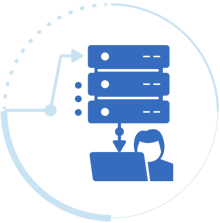Last Updated on January 16, 2025 by Satyendra

Anomaly detection is a powerful tool in any cyber security arsenal, and it consists of detecting deviations from standard patterns. When it comes to banking and finance, it can be used to identify fraudulent activities, in manufacturing it can be used to identify defects, and in cyber security, it’s most commonly used to identify threats.
What is Anomaly Detection?
Anomaly detection (also known as outlier detection) means the detection of deviations in patterns, events, or data. These deviations are referred to as outliers, exceptions, or anomalous observations. Anomaly detection aims to highlight such data points for reconsideration or remedial action.
To put it simply, anomaly detection enables you to spot a needle in a haystack in an automated fashion.
There are many types of anomalies ranging from simple deviations from expectations to dramatic events. Of course, simply identifying the anomaly is one thing. True anomaly detection tools will enable you to investigate and determine the root cause of any anomaly so that you can address any potential issues.

Why is Anomaly Detection Important?
There are many reasons why anomaly detection is highly relevant but, arguably, its two most powerful benefits are the identification of unknown risks and enhanced decision-making. How has anomaly detection become a must-have tool across sectors?
- Fraud Detection– Some of the most crucial applications of anomaly detection include use in the financial and banking industries to help detect fraud. This makes fraudulent activities deviate from normal operations, be it a one-time transaction made in a foreign country or a large sum that was withdrawn. If financial institutions can identify these irregularities, they will be able to minimize further harm.
- Cybersecurity– Anomaly detection is a valuable approach in the cybersecurity field where possible threats include hacking, malware, or data breaches. Hackers like to hide their tracks but anomalous patterns in traffic or system behavior are likely signs of an attack that should not go unnoticed.
- Quality Control and Manufacturing– In manufacturing, anomaly detection assists in detecting faults in the products or equipment being produced. For example, whenever a machine is producing a faulty output or a product is being manufactured badly, such problems will be reflected as data variations in the information collected, say from sensors or quality control. These are the kinds of issues that, when detected by corporations, it is possible to prevent them from evolving into much bigger problems.
- Healthcare Monitoring– Anomaly detection can also be widely used in healthcare; for example, in tracking the changes in patients’ vitals or observing when some medical tests fall outside normal parameters. A sharp decline in pulse rate for instance may suggest an act of health compromise that needs an urgent address. Now if people keep track of the basic values, anomaly detection allows for the early determination of health problems and their subsequent treatment.
- Operational Efficiency– Anomaly detection can be used to measure the efficiency of different execution systems, such as IT or distributed projects in large organizations, supply chains, or logistics. Observing an unexpected pattern in the system or a slow supply chain would enable managers to act appropriately to increase efficiency and, hence, lower operating expenses.
Types of Anomalies
It is also important to have a clear understanding of the different types of anomalies that can be detected before analyzing the techniques of anomaly detection. The type of anomalies differs and the methods of detecting them also vary.
- Point Anomalies– Outliers are defined as data points that are significantly different from the other data points in a given set. Most of the time, these anomalies can be easily identified when compared to the rest of the data since are just outliers. For instance, an unusual peak of website traffic may signal a cyber attack, a DDoS attack.
- Contextual Anomalies– Contextual anomalies, on the other hand, are data points that are quite normal in the general context of the data set but out of the norm when seen within the context of other data sets. For instance, if 80 degrees Fahrenheit is considered normal temperature during the summer, the same temperature would be considered abnormal if it is during winter. Many contextual abnormalities may need some extra information about the environment or context within which the data was gathered.
- Collective Anomalies– Outliers are usually two types; individual and collective where a set of data points deviate from the trend and may not be deviant on their own. For example, if several readings from a sleeve on a piece of manufacturing equipment are out of the ordinary, it could indicate a part has stopped working. Here, the focus is made not on a particular date but on the sequence of occurrences.
Anomaly Detection Techniques
There are a variety of techniques for performing anomaly detection, and all of them are applicable depending on the type of data and problem. Let’s explore some of the most popular methods:
- Statistical Methods– The statistical methods work on the condition that the major part of data is distributed in terms of at least one certain type of distribution such as normal or Gaussian distribution. It is essential to note that any variation that is beyond an identified number or well-understood boundary is defined as an outlier. Common statistical techniques include:
- Z-score: Tells the extent of variability of a given data point with regard to the mean. In case the value of the Z-score exceeds a definite limit, it would categorized as an outlier.
- Gaussian Distribution: Believes that data points have the ‘normal’ distribution with their mean located at the center of the frame and defines outliers as points that are significantly located distant from this center.
- Machine Learning-Based Methods-Anomaly detection using machine learning techniques has also gained a lot of traction because they progressively learn from data. These methods can be broadly divided into two categories:
- Supervised Learning: Incorporates feeding a model with the data set that has anomalous points predetermined. The model then categorizes new points into normal, or anomalous, based on its training. Tools that apply in this step include decision trees, support vector machines (SVM), and neural networks.
- Unsupervised Learning: Unlike supervised learning, this kind of learning does not need the data to be labeled. Other methods like K-means clustering, DBSCAN, and autoencoders are useful in anomaly detection without prior knowledge of the anomaly labels.
- Distance-Based Methods– Distance-based methodology is used to monitor the deviation of data by finding the distance between the values. In case a specific point is outliers, scientifically removed from all the other points in the set then such a point is considered an anomaly. Some common distance-based techniques include:
- K-Nearest Neighbors (KNN): It calculates the distance of a given data point from its k neighbors data points. If the distance to the nearest point is fairly large the point in question becomes an outlier.
- Local Outlier Factor (LOF): Like KNN, LOF calculates the distance value of the local density relative to its closest neighbors.
- Clustering-Based Methods– In this approach, clustering methods are used first to form various clusters and then to look for data points that do not fit into any of the clusters. Some of the approach used includes K-means cluster and DBSCAN which stands for Density-Based Spatial Clustering of Applications with Noise.
- Deep Learning Methods– Deep learning has seen neural networks applied to the detection of anomalous behavior. Among this genus, some autoencoders are mainly used to detect outliers in hypertensive datasets. An autoencoder also captures the input data, compresses it, and then reconstructs similar data from the compressed data. The reconstruction error is used to declare anomalies; that is, the data points with high reconstruction errors are declared anomalies.
Anomaly Detection Applications and Examples
Now that we’ve covered the various types of anomalies and detection techniques, let’s dive into some real-world applications and examples of anomaly detection in action
- Fraud Detection in Banking and Finance– It is worth noticing that anomaly detection is essential when it is about fraudulent activities including credit card fraud, money laundering, and identity theft. For example, if the credit card transaction was completed in a geographical region that is not familiar to the cardholder that is, if a credit card is used in a different country, then that transaction will fall for review. Real-time anomaly detection helps to ensure that such activities are detected as early as possible before affecting customers and or financial institutions.
- Cybersecurity– In cybersecurity specifically, anomaly detection is utilized in discovering strange activity on a network or possible threats. For instance, slowly such actions as logging into the company’s system from a new location at work or accessing sensitive files that the employee normally does not work on can be a pointer to an act of sabotage or insiders’ attack. In addition, by utilizing such features as anomaly detection, an organization can effectively mitigate the risks of such threats as data or system hacking, and other cyber threats.
- Healthcare Monitoring– In healthcare, anomaly detection is applied as a means of keeping track of patient physiology along with patient records. For instance, the system can notify doctors or nurses that the patient’s heart rate has gone up or down from the normal rate and requires attention. This early detection may be the difference between live and dead, particularly in conditions such as a heart attack or a stroke.
- Manufacturing and Quality Control– In manufacturing, it is used to discover problems that may include; manufactured items that are not durable, substandard parts, or broken machinery among others. For instance, an anomaly in temperature monitoring in a production line might suggest a problem with the machines which if not detected will cause many products to be manufactured with defects and thus high return rates and reduced production. The main advantage of monitoring production systems is that their constant assessment can help to identify future problems and increase product quality and productivity.
- Retail and Customer Behavior Analysis– Merchants employ anomaly detection to supervise the activities of their clients and identify suspicious purchasing manners. For example, a drastic shift in customers’ purchase patterns a single large purchase has been possibly fraudulent, or a customer loyalty problem. By identifying such deviations, the retailers can have a better opportunity to deal with customers as well as fight fraud and enhance the efficiency of the marketing campaigns.
How Does Anomaly Detection Work?
The process of anomaly detection typically involves the following steps:
- Data Collection: The first step is concerned with the collection of data from different sources for example through sensors, logs databases, or any external feed.
- Data Preprocessing: Data cleaning, normalization, and transformation are done by examining and filtering the data to eliminate noise and for consistency. This may sometimes entail a process of data cleaning whereby some features may be redundant, some may be missing, and some may require some algorithms to scale the data.
- Feature Extraction: The features or attributes that are relevant to the data that will be mined for anomalies are then chosen out of the whole bunch. This may include statistical measures, patterns, or normative indicators peculiar to a particular domain.
- Model Selection: There is a set of suitable anomaly detection models selected based on the type of data, complexity of data, and kind of results expected. This could be by the use of statistical tools and techniques, machine learning techniques, or deep learning techniques.
- Anomaly Detection: Then, the model is applied to the data to see which data that are anomalies are flagged. What these anomalies are can then be made available for further scrutiny or action.
- Post-Processing: After detection, there is always analysis performed to know the cause of the anomaly and to take action.
How Lepide Helps with Anomaly Detection
The Lepide Data Security Platform has built-in anomaly detection and user behavior analytics that allows you to spot and react to suspicious or unwanted events in real time. Lepide learns what the normal behavior of your users looks like and can notify you when this changes. The solution also contains pre-defined threat models and workflows that utilize anomaly spotting and detailed auditing to detect and respond to all manner of threats to your sensitive data. This might include ransomware, privilege escalation/abuse, compromised user accounts, and more. Once Lepide detects the symptoms of a threat, it can deploy automated actions to contain and mitigate the risk. Lepide is helping thousands of organizations simplify their data security through automating anomaly detection across on-premises, cloud, and hybrid environments
Conclusion
Anomaly detection is a powerful tool that helps businesses and organizations avoid many problems or leave them as little time as possible. Anomaly detection is important in fraud detection and cybersecurity, as well as in manufacturing and healthcare where the use of AI is also considered, to find anomalies and patterns that may pose threats or provide opportunities. Incorporating different types of detection methods including statistic, machine, and deep learning approaches, organizations can be assured of increased capacity in handling big data firms’ challenges.
By incorporating anomaly detection into their systems, companies are not only able to predict problems that may arise but also increase the performance levels of the business, the quality of customer service, and the security of their information. Regardless of the industry of your company, finance or healthcare, for instance, you are likely to enjoy some improvements in your processes and maintain your organization safe from threats with the help of anomaly detection.
If you want to know more about how Lepide can help in anomaly detection, feel free to schedule a demo with one of our engineers today!


 Group Policy Examples and Settings for Effective Administration
Group Policy Examples and Settings for Effective Administration 15 Most Common Types of Cyber Attack and How to Prevent Them
15 Most Common Types of Cyber Attack and How to Prevent Them Why the AD Account Keeps Getting Locked Out Frequently and How to Resolve It
Why the AD Account Keeps Getting Locked Out Frequently and How to Resolve It
